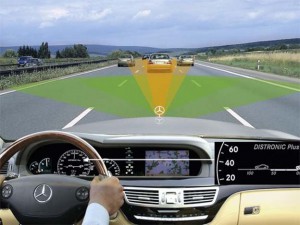
Auto braking is now commonplace on high-end vehicles like the new BMW 750i, but will soon be on most vehicles at all price points.
Ten major vehicle manufacturers from the U.S., Europe and Japan have jointly agreed to make automatic emergency braking systems standard on all their future vehicles.
An advanced form of forward collision warning systems that have already been shown to significantly reduce crashes, have already begun to migrate from high-end luxury models to more mainstream products and a number of automakers already offer auto braking technology as optional equipment. But the announcement means it would become all but ubiquitous.
The move appears to allow the auto industry to take the lead in rolling out auto braking systems, rather than waiting for the federal government to mandate the technology, as had been widely anticipated. At an event in Ruckersville, Virginia today, National Highway Traffic Safety Administration chief Mark Rosekind said the agreement puts the rollout of the technology on the “fast track,” calling it “life-saving technology that everyone should have.”
The various automakers participating in the agreement have not yet set a timeframe for the move, however, and Rosekind made it clear he doesn’t plan to let things drag out, cautioning, “If this can’t get it done, we’ll do it.”
(Autonomous technologies coming to market more and more rapidly. Click Here for more.)
Today’s automobiles are being outfitted with a fast-growing assortment of so-called active safety technologies. Unlike passive safety systems, such as airbags, designed to reduce injuries and fatalities in a crash, the goal is to prevent a collision in the first place.
Forward crash warning technology can use a variety of sensors, most typically radar and artificial vision, to detect when a vehicle is approaching an obstacle too quickly. That can be another car or, in some systems, a bicycle, pedestrian or even a large animal. The system will sound a warning to get the driver’s attention.
Automatic emergency braking, or AEB, systems add a second level of protection. If a driver ignores the alert or doesn’t respond aggressively enough, the vehicle can begin to brake autonomously. Some systems only operate at low speeds, say to 30 miles per hour or so. The most advanced versions, however, can apply braking even at Autobahn speeds.
(2016 BMW 750i adds range of high-tech safety features. Click Here for a review.)
“The evidence is mounting that AEB is making a difference,” said Adrian Lund, president of the Insurance Institute for Highway Safety. NHTSA Administrator Lund was attending a ceremony marking the expansion of the IIHS crash test facility where the auto braking announcement was made.
“Most crashes involve driver error,” emphasized Lund, adding that “This technology can compensate for the mistakes every driver makes because the systems are always on alert, monitoring the road ahead and never getting tired or distracted.”
Both the IIHS and NHTSA have been trying to encourage automakers to add auto braking technology to their vehicles. It is now necessary to receive the Insurance Institute’s top rating for a new vehicle. NHTSA also will consider whether a vehicle has the technology as part of its updated Five-Star New Car Assessment Program.
The private safety group and the federal agency hope to encourage other makers to join the pact, while also pushing truck manufacturers to begin offering the technology.
The 10 manufacturers who have launched the effort are: BMW AG, Ford Motor Co., General Motors Co., Mazda Motor Co, Daimler AG’s Mercedes-Benz, Tesla Motors Inc, Toyota Motor Corp., Volkswagen AG and its Audi AG unit and Volvo. Together they account for 57% of the vehicles sold in the U.S. each year. Other makers, including Fiat Chrysler, are considering joining the coalition.
General Motors welcome “the call for a voluntary industry safety agreement that would lead to making forward collision warning and automatic emergency braking standard on light vehicles,” said Jeff Boyer, GM’s vice president of global vehicle safety.
The move was no surprise to Jeremy Carlson, a senior analyst at IHS Automotive who noted that over the last few years, automatic emergency braking has “proven out in both laboratory and real-world conditions.” The technology has become more commonplace as “prices (have) inched lower, and momentum has increased as regulators paid close attention to a new generation of vehicle safety technology.”
(Report warns motorists often don’t understand – or use – the latest safety features. Click Here for more.)



As long as the AEB systems can be manually disabled by drivers and consumers are not forced to buy these systems then I’m OK with it. There are many times when automated emergency braking will definitely cause you to be in an avoidable accident so the option by competent drivers to disable the AEB is mandatory in my view or no sale.
Yeah, and then the driver disables it and that’s when the accident will happen…..
Accidents are 99% driver error. At fault or not. It’s a driver that causes the accident. Now when ones caused by a malfunction, that can be 90% at drivers fault do to lack of proper maintainance. And no, not just oil changes and tire rotation, proper inspections other than those mandated of local enforcement followed by immediate repairs.
I agree that most accidents are driver error because most drivers don’t take driving seriously. It’s an inconvenience they tolerate to get to a destination.
All of these new electronic gadgets should have a disable button that a driver can use. The black box will record the position of the switch and if a driver has an accident, then it’s on them. I too have seen instances when the electronics is a hindrance and not appropriate for certain situations but we give a driver’s license to anyone in the U.S.
Most U.S. consumers are technically illiterate and have never even read their new car owners manual. they couldn’t check the oil level if their life depended on it – and it might. Since a driver’s license appears to be a God given right in the U.S. then even illegals get them and get to drive taxis in NYC. Ponder that situation for awhile… Illegals, illegally driving U.S. nationals, tourists and “legal’s” around when most illegals can’t even speak the English language. What could possibly be wrong with this scenario?
States like MI that did away with annual auto safety inspections clearly are unconcerned about unsafe vehicles or drivers on the roadways. You would not see a lot of the unsafe junk mobiles on the roadways in states/countries where annual auto safety inspections are required. You also would not see the illegals or cellphone afflicted in many places where they actually enforce the laws.
We have an epidemic of stupidity in U.S. government and it’s destroying America.